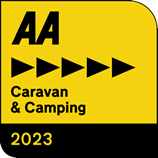The Lake District
Burns Farm lies in the beautiful Valley St-Johns-in-the-Vale. An idyllic part of the Lake District. You just need walk off the site in any direction and it won’t be long before a hill comes underfoot.
From some of the highest ground in England, to the loveliest walk on a disused railway line by the River Greta, this is one of the greatest places on the planet to take your boots.

Threlkeld
Our nearest village, Threlked, is 1 mile away, and just off the A66. There you will find tasty bar meals in three excellent pubs – perfect for a stroll out for an evening drink or refueling worn-out walkers.
There is also a golf course and cricket club boasting some of the best playing experiences in the UK. Along with Threlkeld Quarry & Mining Museum which has lots of fascinating features.

St John's in the Vale
Burns Farm is proud of it’s little jewel ‘Tewet Tarn’, our own little lake set amid the rugged undulating little tors of Low and High Rigg, with picturesque views of the Vale and the campsite with Skiddaw in the background.
Tewet Tarn is ideal for a lovely evening stroll or a nice walk for the kids or your faithful four-legged friend. From there it’s a short walk up Low Rigg to the St John’s-in-the-Vale church from which the valley gets its name.
The church had been a centre for worship for over 400 years.The present building dates from 1845, though there has been a church on the site for much longer. Although located in an isolated spot, the road, which passes the church was once an important road, part of a track, which leads from Matterdale over to Wanthwaite and on to the Naddle Valley. The church welcomes many visitors who happen on it on their journey over High Rigg. The building conveys a warm atmosphere, which is conducive to peace and prayer.

Castlerigg Stone Circle
The stunning Stone Circle at Castlerigg high above Keswick and surrounded by Lakeland fells is just a ‘stones throw’ away. One of the most well-known and best-preserved circle in Cumbria, a ring of 38 stones stands within a spectacular ring of mountains. Looking to the north you see Skiddaw and Blencathara, to the south High Rigg and Helvellyn, to the west the Derwent Fells and to the east through a gap, the Northern Pennines.

Keswick
Keswick, which has only 4,000 inhabitants, is the only town in the Northern Lake District National Park.
The centre of the town is a pedestrian precinct, with plenty of surrounding car parks. The Tourist Information Centre is housed in the middle of Main Street in the Moot Hall, and has all the local information, events and programmes you’ll need, a must at the start of your visit to Keswick. Every day from the Moot Hall there is arranged graded walks organised by the Keswick Rambles.
There’s a street market every Saturday, and a Farmers market every Thursday, where you can find all kinds of local produce.
Keswick has two supermarkets for you to stock up on supplies: Booths and Co-op. Booths are a well known northern chain of supermarkets showcasing the best of the region.
There’s a number of bakeries and delicatessens in town which specialise in sandwiches and packed lunches; in particular try Bryson’s in the Main Street.
Keswick’s particularly famous for its scores of outdoor equipment shops; probably the best, and certainly the best known, is George Fisher right at the top end of the Main Street on Lake Road, but you really won’t have trouble find others!

Theatre by the Lake
The Theatre by the Lake is set on the edge of Derwentwater and amid the magnificent western fells of the Lake District. The building houses a 400-seat Main House, a newly-extended 100-seat Studio, a coffee shop and bars, two gallery spaces, meeting and conference facilities, and a rehearsal room. They present up to 9 of their own productions of classic, modern and new plays throughout the year.

Further Afield
The Lake District offer many towns and villages to explore, whether nestled in valleys, on the side of a lake or along the coastline. At 885 square miles the Lake District is England’s largest national park just waiting to be explored.
Ambleside is full of charm; most of the town is built with local green slate. The fells around offer excellent walking for all abilities.
Windermere is just south of Ambleside and sites on the shore of the great lake Windermere. It is a popular tourist center and is surrounded by easily reached vantage points that give glorious views of the countryside and lake.
Lake Windermere has 14 islands and is more than 10 miles long. Belle Isle one of the islands is privately owned and covers 30 acres.
There are numerous attractions at the lakeside. Why not hop aboard one of the Windermere Lake Cruise boats for a tour of the lake giving breathtaking views. Alternatively, catch the ferry to Fell Foot Park on the far shores of Lake Windermere. The National Trust’s Fell Foot Country Park, offers 18 acres of lawn and trees that stretch down to the water’s edge. This is the perfect place to relax, picnic and take it easy. Just north of Windermere town is Bowness-on-Windermere here you can hire your own rowboat and discover the lake at your leisure.

Walking in the Lake District
The following links, kindly provided by David Kindly, guide you through some of the nicest walks in the Lake District by photo. David’s website, Walk the Fells, has a mound of detailed and mapped walks for you to enjoy.
Long Distance Footpath walkers looking for routes in or crossing the Lake District will not be disappointed. Most famous is probably the Coast to Coast Walk devised by Alfred Wainwright. This 304km (190 miles) route connects St Bees Head in Cumbria with Robin Hood’s Bay in North Yorkshire, with an optional section that crosses the summits of Helvellyn and Striding Edge.
| Route | Distance | Duration |
|---|---|---|
| St John's-in-the-Vale | 4.8 miles | 3 hrs |
| Tewet Tarn | 5.5 miles | 3 hrs |
| High Rigg | – | – |
| Latrigg | 5.6 miles | 2 hrs 20 mins |
| Skiddaw | 14.2 miles | 9 hrs |
| Threlkeld | 9.4 miles | 3 hrs 15 mins |
| Blencathra | 17.3 miles | 6 hrs 5 mins |
| Clough Head | – | – |
| Castlerigg Stone Circle | 4.6 miles | 2 hrs 10 mins |
| Naddle Bridge | 5 miles | 2 hrs 5 mins |
| Naddle Valley | 5 miles | 2 hrs 5 mins |
| Castle Lane | 4.1 miles | 1 hr 30 mins |
| Walla Crag | 6.2 miles | 2 hrs 5 mins |

Cycling in the Lake District
The C2C Cycle Route was developed by Sustrans in partnership with various Local Authorities, Groundwork West Cumbria, North Pennines Tourism Partnership, Forest Enterprise and the Lake District National Park amongst others. The route was opened in 1994, running from Whitehaven on the west coast of Cumbria, to the North East coast at Sunderland, and has an average of between 12,000 and 15,000 cyclists completing the route every year. The old railway track, which is on the Coast to Coast route, runs through the woods by Burns Farm and is within easy access to our campsite.

Watersports in the Lake District
Our nearest is lake is Derwentwater, 4 miles away in Keswick. Derwentwater provides endless sailing opportunities, and if the weather is particularly good, even a little swim! Visit Derwentwater Marina for sailing, wind-surfing, canoeing, kayaking, and even ghyll scrambling and climbing. Or go on one of the regular launches, provided by Keswick Launch Co. – useful to use to get to hop and off at any of the 7 landing stages to get to and from many walks around the area, or just sit back and enjoy a 50 minute round trip and admire some of the most awesome views in the world. Rowing boats and self-drive motor boats are also available for hire at the Keswick boat landings on an hourly or half-hourly basis. There are plenty of Lakes around us too however; Bassenthwaite, Buttermere, Ullswater, Windermere, to name a few, all of which deserve a visit in their own right.

Fishing in the Lake District
The Lake District has a wealth of lakes, rivers and tarns which offer excellent fishing. The deep water trout and the char are the most common. An Environment Agency fishing rod licence is required to fish in all rivers, lakes and tarns. Local byelaws must be observed and a permit is usually required before starting to fish or launch your own craft. Rod licences, Bassenthwaite Lake permits and Keswick Anglers Association permits are available from Keswick Tourist Information Centre. Some fisheries in the area:
- Location: Keswick
- Contact: 017687 73965
- Info: Only fly fishing methods are allowed.
- Fish: Brown trout, Sea trout, Salmon.

Adventure in the Lake District
For the more adventurous, there is a whole host of adventure activities available, which we are ideally situated for.
Watersports, rock climbing, mountain biking, paragliding, Via Ferrata – you can find them all here in the Adventure Capital.
Wildlife
According to BBC Wildlife “When it comes to variety, beauty and abundance of wildlife, Cumbria is the county with everything”, and there’s plenty on offer around Burns Farm.

Birds
Cumbria is rich in birdlife. Over 200 species of bird are recorded in Cumbria in any one year. Many visitors to the Lake District in recent years have shared in the excitement of ospreys breeding in craggy woodland near Bassenthwaite Lake. The Lake District Osprey Project has made viewing these wonderful birds accessible, through telescopes in Dodd Wood and via the webcam display at the Whinlatter Visitor Centre.
There is also amazing interactive bird of prey experiences for all ages. Choose either the woodland and parkland by lake Windermere or the thrill of the Lakeland fells to see eagles, hawks, falcons and owls, and even fly them yourself where possible!

Herdwick Sheep
Herdwick sheep are native to the Lake District fells and survive alone on the mountains all winter. They never stray from their ‘heaf’ – the area they were suckled as lambs.
You can recognise a Herdwick easily as they all have a white face and white legs and their coat changed colour from black as a baby lamb to blue-grey as they get older. The rams are easy to spot too – they have horns.
Herdwick wool is widely used in carpet making and also for knitwear. The fleece is also blended with Swaledale to make loft insulation.

Red Squirrels
Look out for red squirrels in the conifers in Dodd Wood or in Whinlatter Forest. There’s also a Red Squirrel Experience in the Whinlatter Visitor Centre. Their survival is not guaranteed with current estimates suggesting that only about 5,000 reds are left in Cumbria. The work of the Red Squirrels Northern England is crucial in monitoring and checking the advance of the greys. They call on the public’s help in reporting sitings of both red and grey squirrels in an attempt to preserve areas in which red squirrels can live unchallenged.

Otters
Whilst red squirrel numbers threaten to decline, the numbers of otters in Cumbria encouragingly has grown in recent years. By the 1980s otters had almost disappeared from Cumbria, due mainly to toxins in pesticides. There are now growing numbers particularly in the Eden Valley, on the Solway Plain and on the northern stretch of the west coast of Cumbria.









